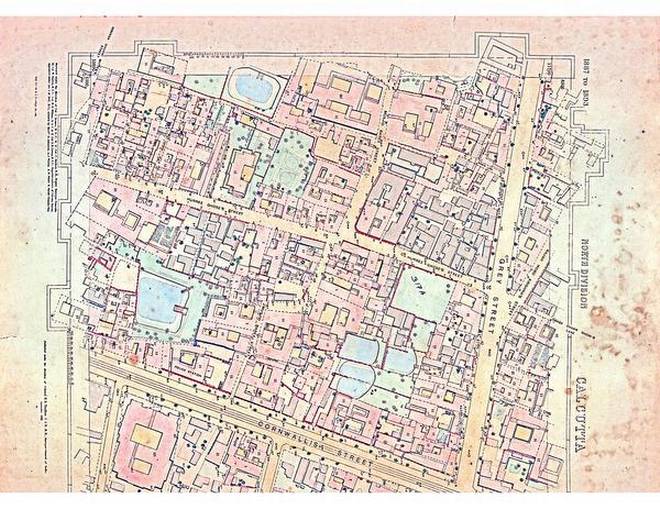
The newly-discovered Kolkata maps, created over a seven-year period, plot buildings, trees, lakes and even dustbins
Almost a hundred years before satellite-based mapping made information available to people at their fingertips, a municipal survey done in Kolkata by British surveyors documented not only streets, houses, landmarks and water bodies but also trees, telegraph and telephone posts, urinals, wells, hackney carriage stands, and dustbins, among others.
The maps of the first major municipal survey of the city carried out over a span of seven years from 1887 are so precise that they follow a scale of 50 feet to an inch. The survey was conducted by Lt. Colonel W.H. Wilkins, who had surveyed Bassein in British Burma. The exercise involved ₹2.38 lakh.
The West Bengal State Archives is now ready with a publication comprising 38 such maps detailing the city’s north division, from Mahratta Ditch in the north, the Hooghly river in the west, the Circular Road, Panchanna Gram in the east and Jorasanko and Kasaripara area in the South.
Titled ‘Calcutta Municipal Maps 1887-1893,’ the publication provides a rare glimpse into the urban history and landscape of Kolkata with the minutest details.
Simonti Sen, the director of State Archives said the painstaking detail in the maps was impressive.
“These maps will not only serve as a milestone to those interested in urban history of the city but can be of immense use to environmentalists who can look up information on water bodies and clusters of trees that existed between 1887 and 1893,” Ms. Sen told The Hindu.
The maps were discovered rolled up in a corner of the State Archives when the renovation of its premises was taken up in 2015. Archivists came across 20 inch x 18 inch sheets with alphanumeric markings that did not make much sense in the beginning.
After a thorough search, scores of such maps were found and it was ascertained that the alphanumeric markings were the order of the maps. The maps were marked on the basis of street names and names of landmarks. Consultations with experts showed that they were part of the survey done by W.H. Wilkins. Each map sheet bears the names of nine or ten surveyors, mostly British, including that of Col. Wilkins.
First effort
“The Calcutta Municipal Corporation was set up in 1876, and this may be the first major survey after that. We believe that the aim of the survey was to increase the tax base of the corporation. One can see the pucca houses and katcha houses being marked differently. Moreover they take into account all municipal infrastructure from sewage lines and drains to telegraph and telephone posts,” Sarmistha De, archivist who has worked extensively on the publication said.
Both Ms. Sen and Ms. De are convinced that the maps, which are being brought to the public domain for the first time, served as the basis of the survey conducted by Major R.B. Smart between 1903 and 1914, which historians call the most “noteworthy of all surveys made on the city till date”.
A changed city
One important thing that the maps point to is the significant change in Kolkata’s green cover and water bodies. They have distinct symbols for different kind of trees, while water bodies are shown as blue spaces, concrete structures are marked pink, and katcha houses, grey.
Almost all 38 maps indicate large open spaces and green. These areas have turned into the most congested parts now.
The maps highlight important educational and cultural institutions of 19th century Kolkata. For instance Bethun College and School, one of the first educational institutions exclusively for girls has been marked as Bethune Female School.
The historic Scottish Church College set up by Alexander Duff in the beginning of 19th century is described as The General Assembly’s Institution in map sheet no. S9. More landmarks such as Duff’s Hindu Girl’s School (sheet no. Q7) and Free Church Institution (sheet no. O3, O4) are also mentioned.
The Star Theatre which conducted its first show on 21 July, 1883 can also be seen at the crossing of Cornwallis Street and Grey Street. (map sheet no S7).
Historians can also find details about the Bengal Music School founded by Rabindranath Tagore, in 1881, referred to in map sheet numbers P4 and P5.
These map sheets also provide a glimpse of the transformation of urban geography.
The name change of some old city streets becomes immediately evident: European names have yielded to Indian ones.
For instance Cornwallis Street changed to Bidhan Sarani, Schalch’s Street to Durgacharan Banerjee Street and Grey Street is now Shree Aurobindo Sarani.
After the current publication, the State Archives plans to reveal 68 other maps.
source: http://www.thehindu.com / The Hindu / Home> News> Cities> Kolkata / by Shiv Sahay Singh / Kolkata – September 30th, 2017